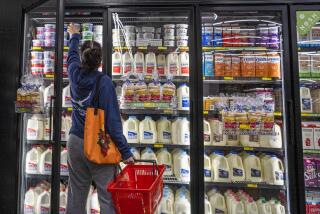2nd Drop in Retail Sales Signals Chill in the Economy
- Share via
WASHINGTON — A chill ran through the economy in October: A second consecutive drop in retail sales and near-stable wholesale prices suggest the long-awaited economic slowdown is taking hold just before the holiday shopping season.
Shoppers spent a seasonally adjusted $213.7 billion last month, down 0.2%, the Commerce Department said Friday. That came after a 0.1% decline in September.
Both drops surprised most economists and troubled a few, coming so close to Christmas. Retail sales make up about a third of the economy’s output, and holiday sales account for as much as half of many retailers’ annual revenues.
Still, much of the weakness was attributed to a slump in auto sales after summertime dealer rebates expired. Department store sales picked up last month as cool weather encouraged fall clothing purchases.
Meanwhile, the Labor Department said that prices paid to producers such as food-processing plants and factories inched just 0.1% higher in October. And the core rate of the producer price index, which excludes often-volatile food and energy costs, was unchanged in October after rising 0.4% a month earlier.
That followed a sharp jump in September and a moderate rise in August. But with a record seven consecutive declines from January through July, the producer price index has declined at a 1.2% annual rate during the first 10 months of the year, compared with a 2.8% increase for all of 1996.
“We seem to be very, very fortunate in the sense that we’re not seeing anything that resembles a surge in spending that could create inflationary pressures,” said economist Norman Robertson of Smithfield Trust Co. in Pittsburgh.
The deceleration, if it persists, could be just what the Federal Reserve Board ordered, analysts said. It would allow the central bank to postpone--perhaps indefinitely--an interest-rate increase aimed at ensuring inflation remains tame.
“What’s happening now is in lieu of interest rates going up. It’s not all bad,” said economist Bruce Steinberg of Merrill Lynch. “Growth was going to slow next year, no matter what. It was going to slow on its own, or the Fed was going to make growth slow.”
Some economists, though, saw danger in the softness coming before the economy has a chance to feel the full impact of domestic stock market turmoil and deteriorating export sales to Asia.
“If the stock market gets in [further] trouble, we think a recession will become probable,” said economist David Levy of Bard College in New York “The downside risks are very serious.”
But the numbers didn’t ruffle Wall Street. The Dow Jones industrial average gained 85 points to close at 7,572. Interest-rates on the benchmark 30-year Treasury bond held around a 21-month low of 6.10% from Thursday’s 6.09%.
In details, the Commerce Department said auto sales fell 2%, the second sizable decline after robust gains from June through August. But department store sales jumped 1.1%, the biggest increase in nine months.
Sales also rose at clothing shops and drugstores. They fell at restaurants and bars and building-supply and hardware stores. Furniture sales were unchanged.
Producer prices were well-behaved overall in October, despite a 16.8% surge in vegetable costs that helped push food prices up by 0.4%. That included a near-quadrupling of cauliflower and a doubling of broccoli. But meat and egg prices fell. A 6.4% drop in pork was the most in almost a decade.
The seasonally adjusted price of new cars shot up 0.7%, but prices fell for trucks, footwear and health products.
Energy costs rose only 0.1%. Gasoline prices fell, but heating oil, residential natural gas and electricity rose.
For the first 10 months of this year, prices excluding food and energy rose at a 0.3% annual rate.
(BEGIN TEXT OF INFOBOX / INFOGRAPHIC)
Producer Prices
A seasonally adjusted index that measures inflation at the wholesale level. 1982: 100
October ‘97: 132.1
Source: Bureau of Labor Statistics
Retail Sales
Seasonally adjusted, in billions of dollars:
October ‘97: $213.7
Source: Commerce Department
More to Read
Inside the business of entertainment
The Wide Shot brings you news, analysis and insights on everything from streaming wars to production — and what it all means for the future.
You may occasionally receive promotional content from the Los Angeles Times.










